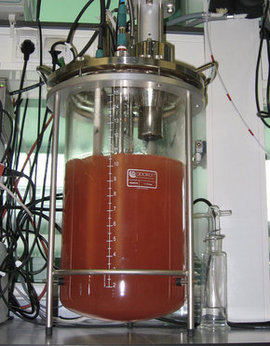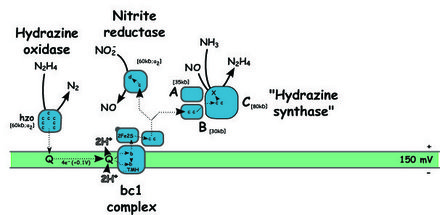Page path:
- Press Office
- Highlights 2000 - 2011
- 03.10.2011 Molecular mechanism of the anaerobic...
03.10.2011 Molecular mechanism of the anaerobic ammonium oxidation (anammox) unraveled
The anaerobic oxidation of ammonia (anammox) is an important pathway in the nitrogen cycle that was only discovered in the 1980s. Currently, scientists estimate that about 50% of the nitrogen in the atmosphere is forged by this process. A group of specialized bacteria perform the anammox reaction, but so far scientists have been in the dark about how these bacteria could convert ammonia to nitrogen in the complete absence of oxygen. Now, 25 years after its discovery, they finally solved the molecular mechanism of anammox. Dr. Marc Strous, since two years at the Max Planck Institute for Marine Microbiology in Bremen, is one of the principal investigators.
Anammox bacteria are very unusual because they contain an organelle which is a typical eukaryotic feature. Inside this organelle, known as the “anammoxosome”, the bacteria perform the anammox reaction. The membrane of the anammoxosome presumably protects the cells from highly reactive intermediates of the anammox reaction. These intermediates could be hydrazine and hydroxylamine, as microbiologists proposed many years ago. This was very exciting news because the turnover of hydrazine, a very powerful reductant also used as rocket fuel, had never been shown in biology. However, these early experiments were provisional and many open questions remained.
Anammox bacteria are very unusual because they contain an organelle which is a typical eukaryotic feature. Inside this organelle, known as the “anammoxosome”, the bacteria perform the anammox reaction. The membrane of the anammoxosome presumably protects the cells from highly reactive intermediates of the anammox reaction. These intermediates could be hydrazine and hydroxylamine, as microbiologists proposed many years ago. This was very exciting news because the turnover of hydrazine, a very powerful reductant also used as rocket fuel, had never been shown in biology. However, these early experiments were provisional and many open questions remained.

An anammox culture in a membrane bioreactor. The red color is due to the heme c group of the protein cytochrome c, that plays an important role in the anammox metabolism (Image courtesy of B. Kartal).
To finally unravel the pathway experimentally was a very difficult enterprise. Marc Strous from the Max Planck Institute in Bremen says: “The anammox organisms are difficult to cultivate because they divide only once every two weeks. Therefore we had to develop cultivation approaches suitable for such low growth rates. Even after 20 years of trials, we can still only grow the organisms in bioreactors and not in pure culture.” In the present study, the researchers make use of the latest innovation in bioreactor technology for anammox cultivation: the membrane bioreactor. In such bioreactors the anammox organisms grow as suspended cells rather than in biofilms on surfaces, and relatively few contaminating organisms are present. The study makes use of protein purification, and proteins cannot be effectively purified from biofilms because of the large amount of slime associated with these biofilms.
Another important key to the metabolism was the availability of the genome sequence of one of the best know anammox bacteria, Kuenenia stuttgartiensis. With the knowledge of the genome, the authors knew which proteins could be important. Based on the genome sequence, they could predict that nitric oxide, not hydroxylamine, might be the precursor for hydrazine. With a set of state-of-the art molecular methods the scientists could thus completely unravel the anammox pathway, and unequivocally establish the role of hydrazine and nitric oxide (NO) as intermediates.
Another important key to the metabolism was the availability of the genome sequence of one of the best know anammox bacteria, Kuenenia stuttgartiensis. With the knowledge of the genome, the authors knew which proteins could be important. Based on the genome sequence, they could predict that nitric oxide, not hydroxylamine, might be the precursor for hydrazine. With a set of state-of-the art molecular methods the scientists could thus completely unravel the anammox pathway, and unequivocally establish the role of hydrazine and nitric oxide (NO) as intermediates.

Schematic diagram of the enzymes and reactions during electron transport at the membrane of and within the anammoxosome (Diagram by M. Strous).
“With this significant advance we can finally understand how the nitrogen in the air we breathe is created: from rocket fuel and nitric oxide!” concludes Marc Strous. With the establishment of the prominent role of nitric oxide in both anammox and denitrification, the research also opens a new window on the evolution of the biological nitrogen cycle in the Earth's distant past. Marc Strous explains: ”In the early days in Earth’s history, the nitric oxide accumulated in the atmosphere by vulcanic activity, was presumably the first “deep electron sink” on earth and may so have enabled the evolution of both microbial metabolic pathways anammox and denitrification.”
For further information, please contact
Prof. dr. ir. Marc Strous 0421 2028 822 [Bitte aktivieren Sie Javascript]
or the public relations office
Dr. Rita Dunker 0421 2028 856 [Bitte aktivieren Sie Javascript]
Dr. Manfred Schlösser 0421 2028 704 [Bitte aktivieren Sie Javascript]
Original publication
Molecular mechanism of anaerobic ammonium oxidation. B. Kartal, W. J. Maalcke, N. M. de Almeida, I. Cirpus, J. Gloerich, W. Geerts, H. J. M. Op den Camp, H. R. Harhangi, E. M. Janssen-Megens, K.-J. Francoijs, H. G. Stunnenberg, J. T. Keltjens, M. S. M. Jetten, and M. Strous. Nature, 2011
doi: 10.1038/nature10453
Involved institutions:
Institute for Water and Wetland Research, Department of Microbiology, Radboud University, Nijmegen, The Netherlands
Nijmegen Centre for Mitochondrial Disorders, Nijmegen Proteomics Facility, Department of Laboratory Medicine, Radboud University Nijmegen Medical Centre, Nijmegen, The Netherlands
Radboud University, Department of Molecular Biology, Nijmegen Centre for Molecular Life Sciences, Nijmegen, The Netherlands
Delft University of Technology, Department Biotechnology, Delft, The Netherlands
Max Planck Institute for Marine Microbiology, Bremen, Germany
For further information, please contact
Prof. dr. ir. Marc Strous 0421 2028 822 [Bitte aktivieren Sie Javascript]
or the public relations office
Dr. Rita Dunker 0421 2028 856 [Bitte aktivieren Sie Javascript]
Dr. Manfred Schlösser 0421 2028 704 [Bitte aktivieren Sie Javascript]
Original publication
Molecular mechanism of anaerobic ammonium oxidation. B. Kartal, W. J. Maalcke, N. M. de Almeida, I. Cirpus, J. Gloerich, W. Geerts, H. J. M. Op den Camp, H. R. Harhangi, E. M. Janssen-Megens, K.-J. Francoijs, H. G. Stunnenberg, J. T. Keltjens, M. S. M. Jetten, and M. Strous. Nature, 2011
doi: 10.1038/nature10453
Involved institutions:
Institute for Water and Wetland Research, Department of Microbiology, Radboud University, Nijmegen, The Netherlands
Nijmegen Centre for Mitochondrial Disorders, Nijmegen Proteomics Facility, Department of Laboratory Medicine, Radboud University Nijmegen Medical Centre, Nijmegen, The Netherlands
Radboud University, Department of Molecular Biology, Nijmegen Centre for Molecular Life Sciences, Nijmegen, The Netherlands
Delft University of Technology, Department Biotechnology, Delft, The Netherlands
Max Planck Institute for Marine Microbiology, Bremen, Germany
